Film Review:From Russia with Love (1963)
- Ryota Nakanishi

- Jul 5, 2019
- 6 min read
Updated: Apr 5, 2024

From Russia with Love (1963)
From Russia with Love (1963) is undoubtedly the best 007 film ever made. Its intelligent adjustment is that they avoided the Cold War narrative which is today called ''Russophobia.'' In detail, they changed SMERSH (Soviet counter-intelligence agency) into fictional SPECTRE. Originally Ian Fleming put anti Soviet narrative into his 007 novel however the adaptation made this film superior than the original film.
As the result, SPECTRE 's role is very close to real intelligence agencies. Their scheme is to play with both British and Soviet intelligence agencies changed the entire story structure more insightfully and suspense-fully. A Lektor cryptography device is stolen by SPECTRE themselves from the Soviet Consulate in Istanbul and ultimately sold to Soviet Union.
During this mafia-like business, SPECTRE orders Rosa Klebb (Number 3), a former SMERSH (Soviet counter-intelligence) colonel to recruits Tatiana Romanova, a cipher clerk at the Soviet consulate in Istanbul who still believes Klebb works for Soviet. SPECTRE's another goal is to revenge 007 for Dr. No. A sex scandal between UK and USSR, and suicide of 007 are planned.
This film has three kinds of narrative layers. Such as false narrative, official narrative and true narrative. False narrative is created by Grant (Robert Shaw) ; official narrative is shared between UK and USSR; the true narrative is witnessed by the audience. It makes this film the best 007 film.
Story Structure
ACT 1 is exposition before Istanbul. SPECTRE starts training of assassins, Irish assassin Donald "Red" Grant (Robert Shaw) is one of them. Inciting incident is Ernst Stavro Blofeld (Anthony Dawson) orders SPECTRE's chief planner, Czech chess grandmaster Kronsteen (Number 5) to plan a revenge for Dr. No and puts Rosa Klebb (Number 3), a former SMERSH (Soviet counter-intelligence) colonel, in charge of the mission. This Blofeld decision is the inciting incident of the entire film.
Tatiana Romanova is forced to accept Rosa Klebb (Number 3)'s ''order'' and contacts MI6 for defection with a MacGuffin, LECTOR, then, M (Bernard Lee) orders 007 James Bond (Sean Connery) to go to Istanbul to help her even though they know it would be a trap. This is the end of ACT1. ACT1 of this film is a perfect example of ACT1 as EXPOSITION.
ACT2 is formed by the entire Istanbul-Orient Express sequences. Meeting Station T chief Ali Kerim Bey (Pedro Armendáriz) is Bond's first step to reach Tatiana Romanova however it involves Bond into a years of conflict between Bulgarian Soviet agent Krilencu (Fred Haggerty) and Ali Kerim Bey. This is the first half of ACT2's conflict. Krilencu sets a limpet bomb in Ali's office, Bond and Ali spy on the Russian consulate to identify the bomber is Krilencu, after the battle in the Station T's hideout gypsy camp, Bond and Ali track down Krilencu and kill him with Bond's rifle. The First Half of ACT2's conflict is perfectly built and dealt with MI6 agents. Grant helps Bond secretly to let him steal a LECTOR smoothly.
Midpoint is that after Bond gets a consulate floor plans from Tatiana Romanova and steals a LECTOR from the Soviet consulate in Istanbul, Bond and Tatiana Romanova decide to escape with it by Oriental Express. This is a solution to the ACT1 and the first half of ACT2's conflicts. Grant helps Bond to kill other Bulgarian agent to ensure Bond receives the floor plans.
The last half of ACT2 is a conflict between Grant (Robert Shaw) and Bond in the Oriental Express. Grant kills both Soviet agent Benz and Ali to prevent rendezvous of Bond and Soviet. The aim is to get a LECTOR and stage Bond and Tatiana's scandalous deaths ultimately. A brief stop at the Belgrade station sets up the Station Y's agent Nash's death at Zagreb where Grant pretends to be Nash to get close with Bond. Then, Grant drugs Tatiana and assault Bond. At the end of ACT2, Bond is in the most dangerous situation and Grant reveals truths about a recruit of Tatiana and staging scandalous deaths of Bond and Tatiana. Bond tricks Grant into setting off the booby trap in the attache case and stabs him with a switch knife and strangles him with his own garrotte. They flee with Grant's getaway track.
ACT3 is a synthesis of ACT1 and ACT2. It starts from the execution of the failed Number 5, and Blofeld orders Klebb to acquire a LECTOR in order to sell it back to Soviet.
After escape from SPECTRE's helicopter attacks, Bond and Tatiana steal Grant's escape boat on the Dalmatian coast and deal with Morzeny's squadron of SPECTRE powerboats. Finally at Venice's hotel room, Klebb disguises as a maid and attacks Bond however Klebb is shot by Tatiana. Their mission accomplishes and Bond throws away Grant's blackmail sex film in the canal of Venice.
Three Act Structure is perfectly and ideally applied in this film as mentioned above. Suspense and spy films are best examples for understanding this universal standard of cinematic story telling. It reveals that decision making is nature of plotting. In other words, expression of violence itself is not a ''plot,'' not an essential part of story-telling. Plot is decision making. Story structure is made from decisions of main characters who engage in conflicts.
Technical Aspects
For film editing, Terence Young (1915-1995) dislikes master shots. He did not shoot any master shots for his films including this film. Terence Young followed John Ford (1895-1973). Moreover, Young intended to avoid close ups. As the result, there are a few close ups in his films. Minimal use of close ups is his one of signatures.
Terence Young used at most three cameras for shooting this film, From Russia with Love (1963). Multi-Camera work is standard of the successful genre films. 007 is not a single camera work. Three cameras used to shoot the fight of Bond and Grant in the Oriental Express.
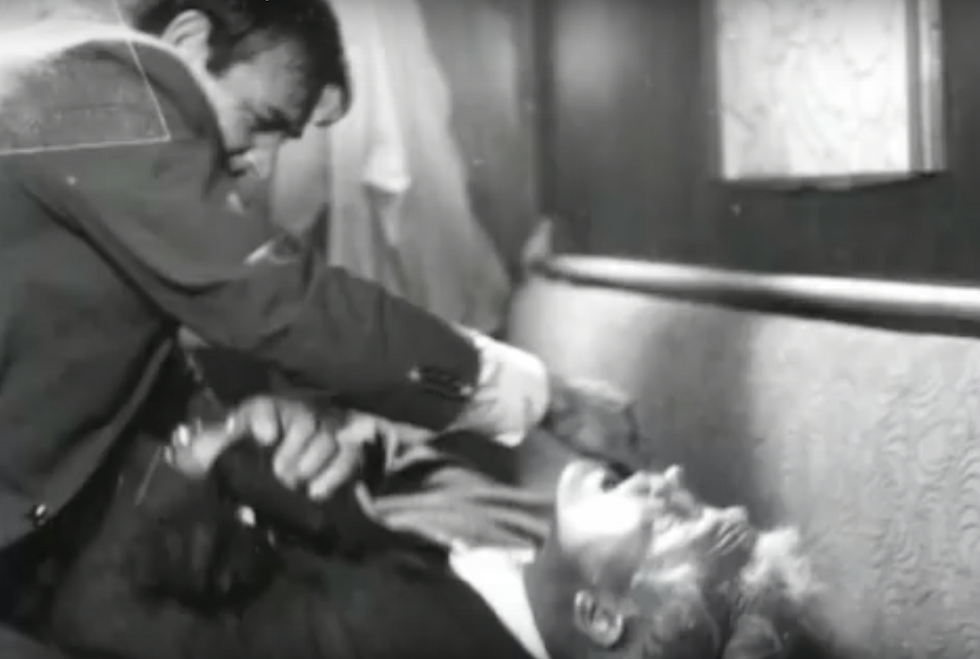
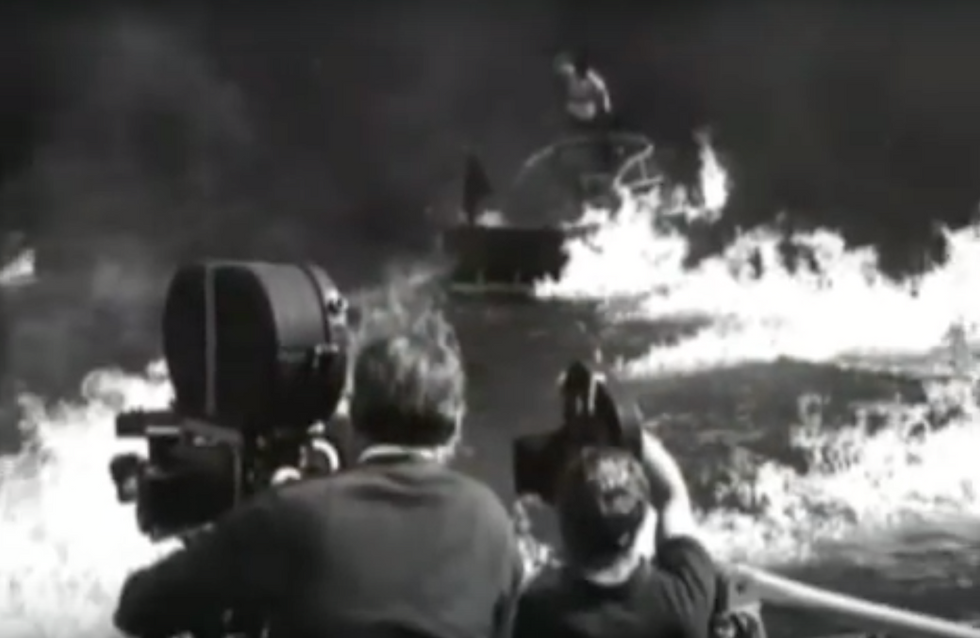
Their film is not completely based on story board but they shot another sequences did not exist in original scripts and story board. As the result, the film editor Peter Hunt (1925-2002)'s editorial role was decisive on the final film version.
The illness of Mexican actor Pedro Armendáriz did not drastically affect the entire film structure however the script itself had major flaw in EXPOSITION. Then Peter Hunt rearranged the narrative order of EXPOSITION and it was a really idealistic editorial job. It proved that a film editor must understand story-telling and its standard of story structure to save the film. Here is the example. The original script order of EXPOSITION was 1) Klebb to SPECTRE Island; 2) Klebb recruits Tatiana; 3) Chess match; 4) Meeting at Blofeld's yacht. It was quite vague to understand the narrative as EXPOSITION.
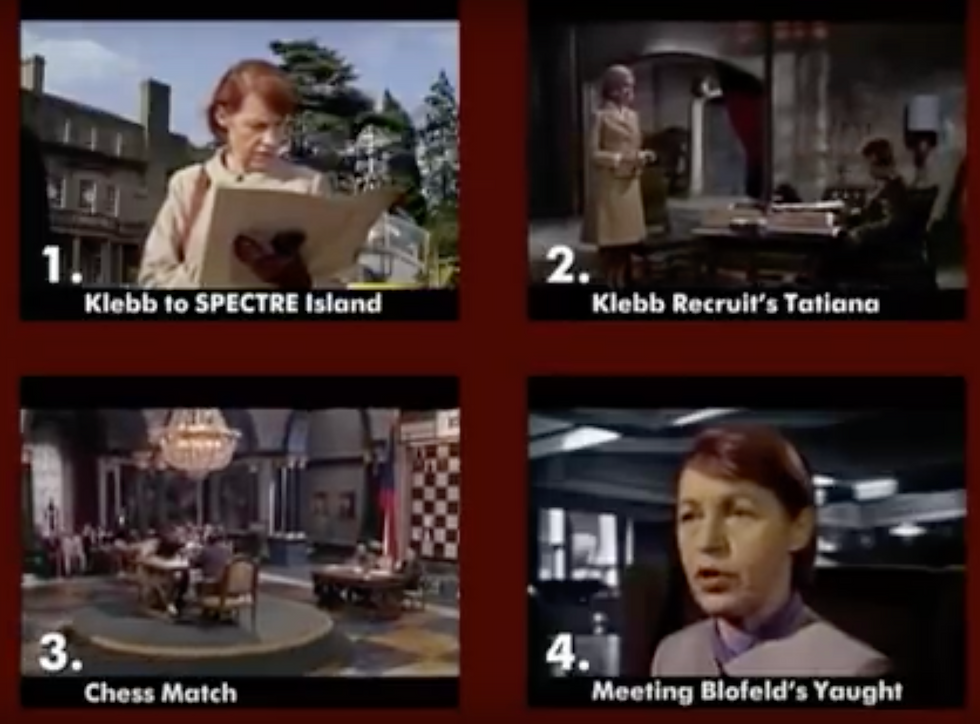
Thus, the film editor Hunt rearranged it into 1) Chess Match; 2) Meeting at Blofeld's yacht; 3) Klebb to SPECTRE Island; 4) Klebb recruits Tatiana. It works as EXPOSITION. This is a film editor's idealistic job during filmmaking. Film editing is part of story-telling.
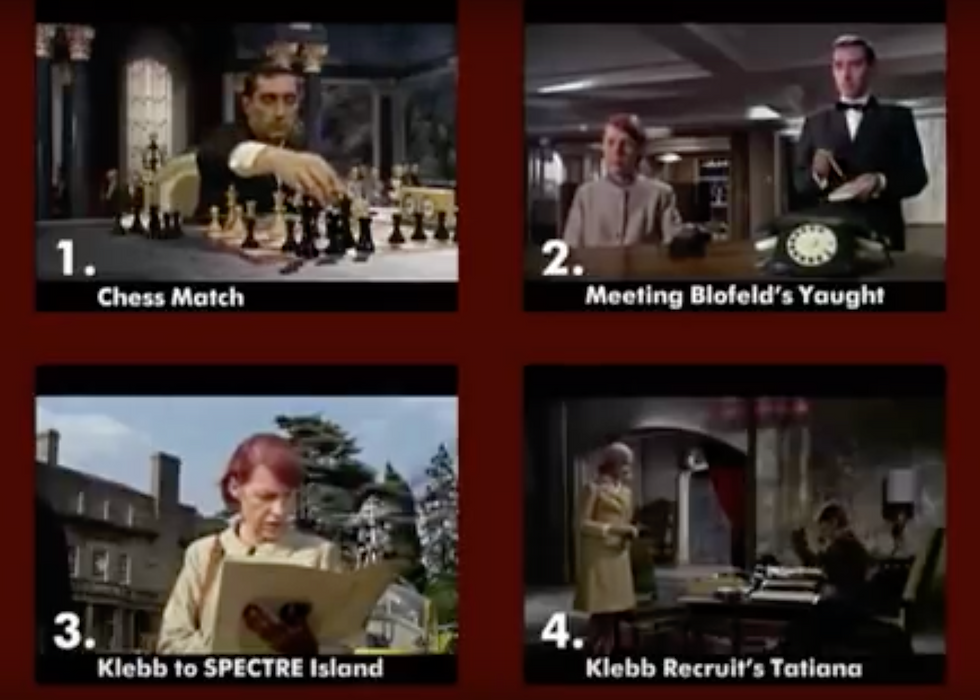
Back / Rear projection was frequently used in 007 films of that era. It was useful when it was impossible to re-establish the same set, it only needs the same actor to reshoot at anywhere at the studio.
Editing the sequence of Klebb at meeting in Blofeld's yacht later lacked her medium shot but there was no set at the time of editing. Thus Hunt suggested Young to do rear projection.
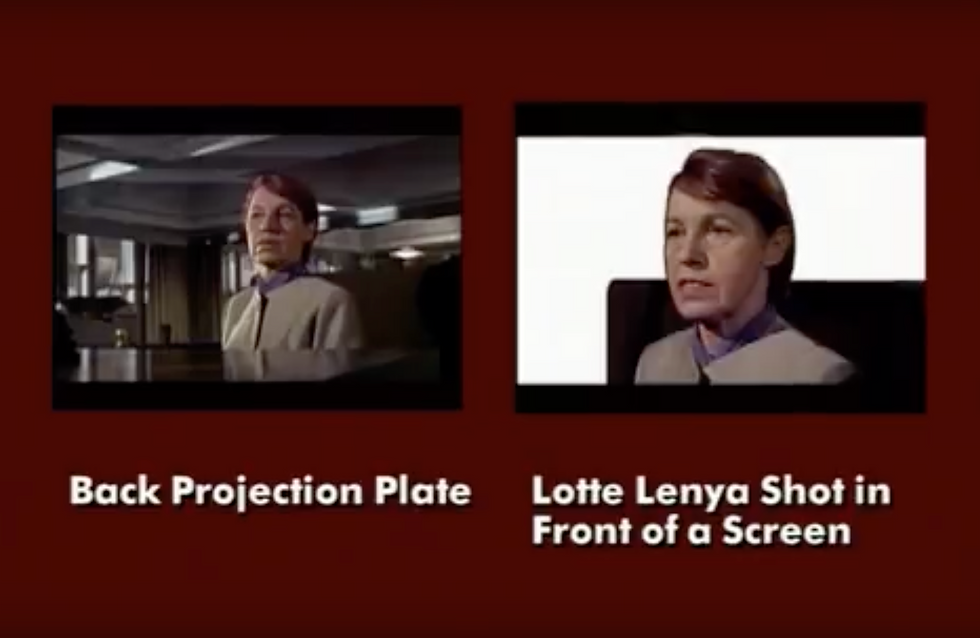
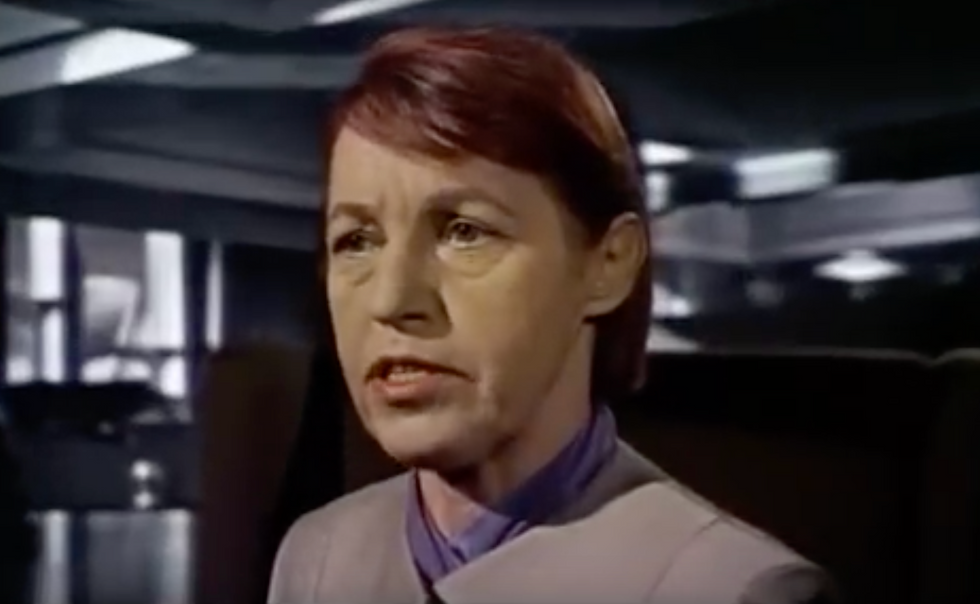
This rear projection is not perfect in colour temperature but it is unnoticed by audience successfully. Invisible editing is good editing like this rear projection. If no one mentions, no audience is noticeable on the hidden edit. Another example of invisible editing is reverse action. This reverse action is also completely unnoticed by the audience. It is superior than Eisenstein's obvious reverse actions. When Klebb walks toward the home aquarium at Blofeld's yacht, the action is reverse action, then Klebb walks away from the home aquarium in where fishes fight with each other. It was a same shot but it created the imaginary action of Klebb walking toward the home aquarium.
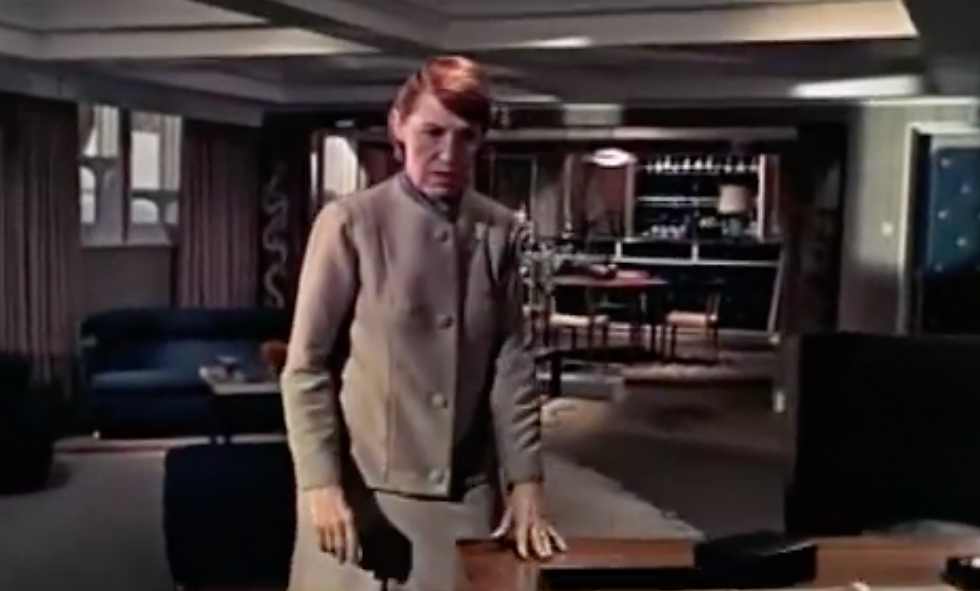
Akira Kurosawa (1910-1998) mentioned the difference between Japanese editing and Western editing. The main difference is pacing. Peter Hunt is a good example, his editing is good at quick pace in any way. For example, when Ali and Bond walks out from their office, Hunt directly cuts to a shot they walking down steps of Basilica Cistern. If this was a Japanese film, it would have shown many shots between them to connect different places. Hunt's action match cutting actually cut off unnecessary shots between the office and underground palace where ''no story'' occurred.
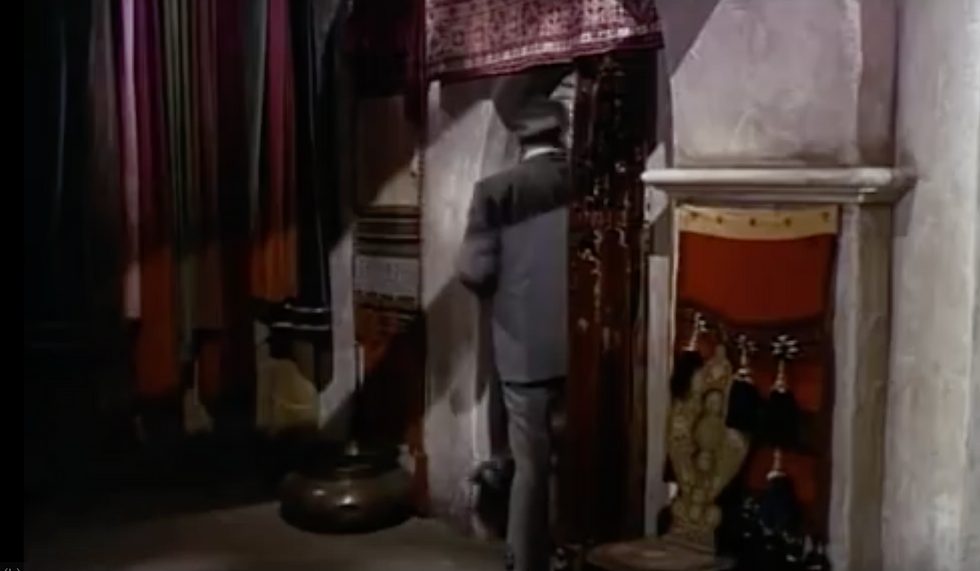
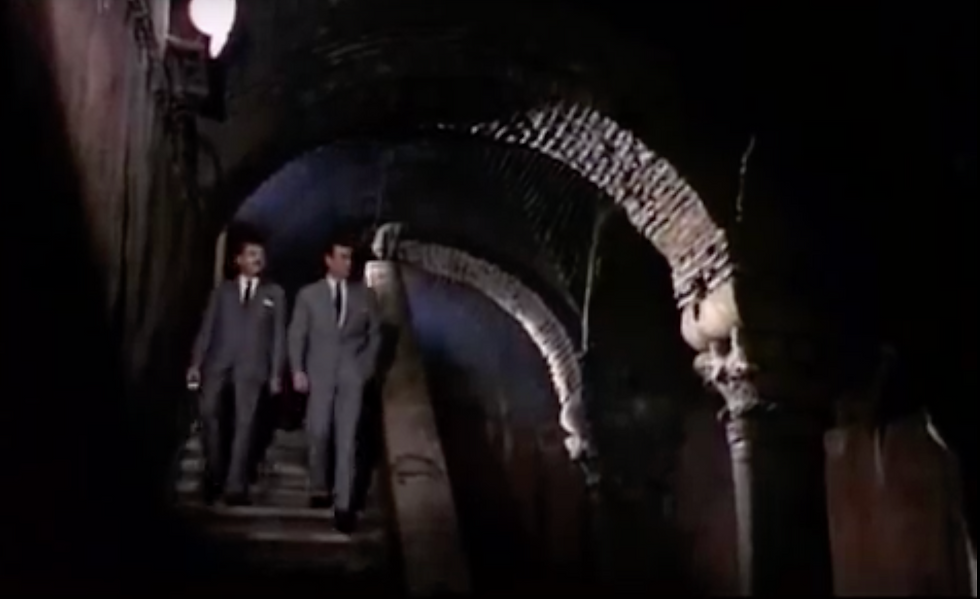
From Russia with Love (1963) is a perfect example of story-telling and film editing. There is no doubt that this 007 film is the best of the bests among all James Bond films.
This film, From Russia with Love (1963) is highly recommended for all film students and 007 fans.
Any part of this report may be disseminated without permission, provided attribution to the professional film writer Ryota Nakanishi as author and a link to www.ryotanakanishi.com is provided.
This film article is for educational purpose only.
Copyright Disclaimer Under Section 107 of the Copyright Act 1976, allowance is made for "fair use" for purposes such as criticism, comment, news reporting, teaching, scholarship, and research. Fair use is a use permitted by copyright statute that might otherwise be infringing. Non-profit, educational or personal use tips the balance in favour of fair use.




Comments